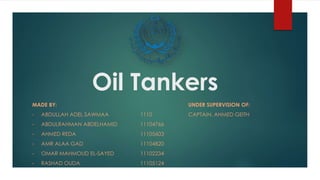
Crude Oil Carriers Types / Oil Tankers
- 1. Oil Tankers MADE BY: UNDER SUPERVISION OF: • ABDULLAH ADEL SAWMAA 1110 CAPTAIN. AHMED GEITH • ABDULRAHMAN ABDELHAMID 11104766 • AHMED REDA 11105603 • AMR ALAA GAD 11104820 • OMAR MAHMOUD EL-SAYED 11102234 • RASHAD OUDA 11105124
- 2. Table of contents Types of oil tankers History The supertanker ear Size categories
- 3. Types of oil tankers Is a merchant ship designed for the bulk transport of oil. There are two basic types of oil tankers: the crude tanker and the product tanker. Crude tankers move large quantities of unrefined crude oil from its point of extraction to refineries. Product tankers, generally much smaller, are designed to move refined products from refineries to points near consuming markets
- 4. Longest ship ever built
- 5. History of Oil Tankers In the early 1850s, oil began to be exported from Upper Burma, then a British colony. The oil was moved in earthenware vessels to the river bank where it was then poured into boat holds for transportation to Britain In the 1860s, Pennsylvania oil fields became a major supplier of oil, and a center of innovation, Break-bulk boats and barges were originally used to transport Pennsylvania oil in 40-US-gallon (150 l) wooden barrels. But transport by barrel had several problems because of its weight and cost, it reach to the half cost of oil production In 1863, two sail-driven tankers were built on England's River Tyne. These were followed in 1873 by the first oil-tank steamer, the Vaderland, which was built by Palmers Shipbuilding and Iron Company for Belgian owners The modern oil tanker was developed in the period from 1877 to 1885. In 1876, Ludvig and Robert Nobel, brothers of Alfred Nobel, founded Branobel (short for Brothers Nobel) in Azerbaijan. It was one of the largest oil companies in the world
- 6. Zoroaster the world's first tanker for Nobel brothers
- 7. The supertanker era Until 1956, tankers were designed to be able to navigate the Suez Canal the ultra-large crude carriers (ULCC) built in the 1970s were over 1,300 feet (400 m) long and had a capacity of 500,000 DWT In 1955 the World's largest supertanker was 30,708 GRT[26] and 47,500 LT DWT In 1958 United States shipping magnate Daniel K. Ludwig broke the record of 100,000 long tons of heavy displacement. His Universe Apollo displaced 104,500 long tons, a 23% increase from the previous record-holder, Universe Leader which also belonged to Ludwig The world's largest supertanker was built in 1979 at the Oppama. This ship was built with a capacity of 564,763 DWT, a length overall of 458.45 metres (1,504.1 ft) and a draft of 24.611 metres (80.74 ft). She had 46 tanks, 31,541 square metres (339,500 sq ft) of deck, and at her full load draft, could not navigate the English Channel. As of 2011, the world's two largest working supertankers are the TI class supertankersTI Europe and TI Oceania. These ships were built in 2002 and 2003
- 8. Size categories AFRA Scale Flexible Market Scale Class Size in DWT Class Size in DWT New Price Used Price General Purpose tanker 10,000–24,999 Product tanker 10,000–60,000 $43M $42.5M Medium Range tanker 25,000–44,999 Panamax 60,000–80,000 LR1 (Large Range 1) 45,000–79,999 Aframax 80,000–120,000 $60.7M $58M LR2 (Large Range 2) 80,000–159,999 Suezmax 120,000–200,000 VLCC (Very Large Crude Carrier) 160,000–319,999 VLCC 200,000–320,000 $120M $116M ULCC (Ultra Large Crude Carrier) 320,000–549,999 Ultra Large Crude Carrier 320,000–550,000
- 9. PANAMAX AND HANDYSIZE These tankers are primarily used for both the transportation of crude oil and petroleum products. Panamax tankers have displacement between 50,000 and 80,000 dwt and trade in short haul. Handysize tankers have displacement between 50,000 and 10,000 dwt. They primarily carry finished petroleum products as their smaller size makes them less economic for the transport of crude. General Maritime currently owns a fleet of 2 Panamax and 4 Handysize vessels.
- 10. AFRAMAX Aframax vessels are mid-size tankers with displacement between 80,000 and 120,000 metric tons. Aframax vessels typically engage in medium to short haul oil trades in nearly all operating regions and can carry cargos of 80,000 to 120,000 dwt. Widely considered to be the work horses of the fleet, their size makes them ideally suited to operate in areas of lower crude production or where draft and size restrictions prevent the use of larger vessels. General Maritime currently owns and operates a fleet of 12 Aframax tankers.
- 11. SUEZMAX Suezmax are midsized tankers with displacement between 120,000 and 200,000 dwt. Suezmax tankers offer the relative economies of scale that can be achieved with VLCCs; however, their slightly smaller size offers increased versatility and access to a majority of the world’s ports. Suezmax tankers primarily operate in the Atlantic Basin delivering cargoes from West Africa, the North Sea, and the former FSU. General Maritime currently owns and operates a fleet of 11 Suezmax vessels.
- 12. ULCCS (ULTRA LARGE CRUDE CARRIER) AND VLCCS (VERY LARGE CRUDE CARRIER) These are the largest vessels in the world tanker fleet. They carry cargos of 200,000 dwt or greater and typically transport oil in long-haul trades mainly from the Arabian Gulf to Western Europe and the United States via the Cape of Good Hope and Asia.
- 13. Hellespont Alhambra (now TI Asia), a ULCC TI class supertanker, which are the largest ocean-going oil tankers in the world
- 14. Thank You
